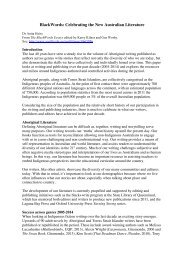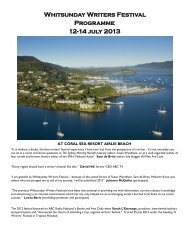7209743364812265548-Aboriginal-Literature-for-Children
7209743364812265548-Aboriginal-Literature-for-Children
7209743364812265548-Aboriginal-Literature-for-Children
Create successful ePaper yourself
Turn your PDF publications into a flip-book with our unique Google optimized e-Paper software.
The general concept and message of Fair Skin Black Fella remains: <strong>Aboriginal</strong> identity is notabout the colour of your skin. As Old Ned says: ‘We all brothers and sisters in this life, nomatter what colour we are’.A different perspective on contemporary identity appears in Boori Monty Pryor’s Shake ALeg (Allen & Unwin, 2010). Illustrated by Jan Ormerod, the work took out the 2011 PrimeMinister’s Literary Award <strong>for</strong> <strong>Children</strong>’s Fiction. Inspired by members of his own familywho hail from Northern Queensland and the Birrigubba and Kungganji nations, Pryor haswoven his ancient traditions, culture and stories into a modern day yarn.Through the story of three young fellas hunting <strong>for</strong> pizza the reader gets an insight intocontemporary <strong>Aboriginal</strong> life. It’s a place where Blackfellas speak Italian, where Murris arechefs, nurses and sound engineers, where crocodile pizza is washed down with milkshakesand where the busy street acts as the bora ring today. It’s also where people can live in citiesand still respect and value thousands of years of culture. In short, it’s a story that breaks downstereotypes of what it means to be <strong>Aboriginal</strong>.Not all books are award-winning or coming out of established publishing houses though. OldWay New Way was written and produced by Weetangera Primary School in Canberra, andlooks at the expression of identity through traditional art and culture alongside its expressionthrough contemporary art <strong>for</strong>ms, modern day technologies, mediums and ways of doingthings. For example, the kids use clapsticks the old way and play musical instruments like thesax the new way. They like rock art old way and digital art new way.The book was designed by the students as a ‘home reader’ style book, as well as a celebrationof the journey that the school’s “Yirri Dancers” have been on.<strong>Aboriginal</strong> anthems make important kids booksOur cultural evolution in Australia means our young people now have access to song lyricsthat enrich, engage, entertain and educate.Four titles out of Melbourne-based publisher One Day Hill have brought to the page some ofAustralia’s most well-known <strong>Aboriginal</strong> anthems, written and per<strong>for</strong>med by some of thecountry’s most loved Australian musicians –black and white – married with artwork fromcommunity kids and professional painters.The first book From Little Things Big Things Grow is about the story of Vincent Lingiagri,the beginning of the land rights movement, and the strength and will of the Gurindji people tofight <strong>for</strong> what was rightfully theirs. It was originally released by musical icons Kev Carmodyand Paul Kelly back in 1993, and it remains a melody that most <strong>Aboriginal</strong> Australians know.This ‘anthem of hope’ was published as a beautiful picture book in 2008, with illustrations bykids from Gurindji country and paintings by Peter Hudson. This picture book is perfect <strong>for</strong>introducing significant Australian history into the classroom in an entertaining and accessibleway.The second title mentioned earlier is Solid Rock (Sacred Ground), first penned as lyrics byShane Howard following an experience he had at Uluru in 1981. It was one of the first songsto hit the commercial airwaves that discussed the dispossession of <strong>Aboriginal</strong> people fromtheir land and the truth behind first contact: invasion, warfare, and the consequences ofcolonization <strong>for</strong> <strong>Aboriginal</strong> peoples.




